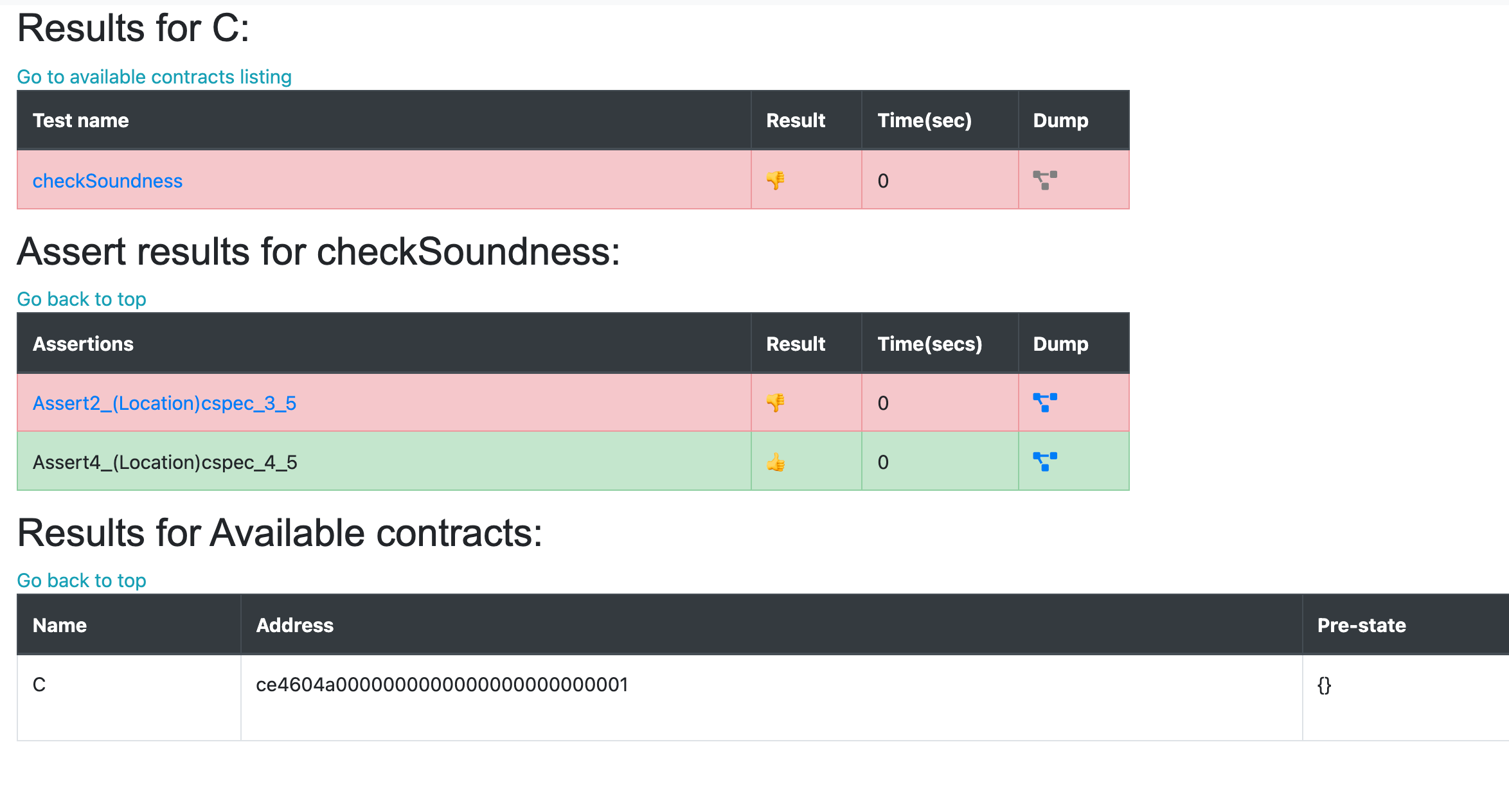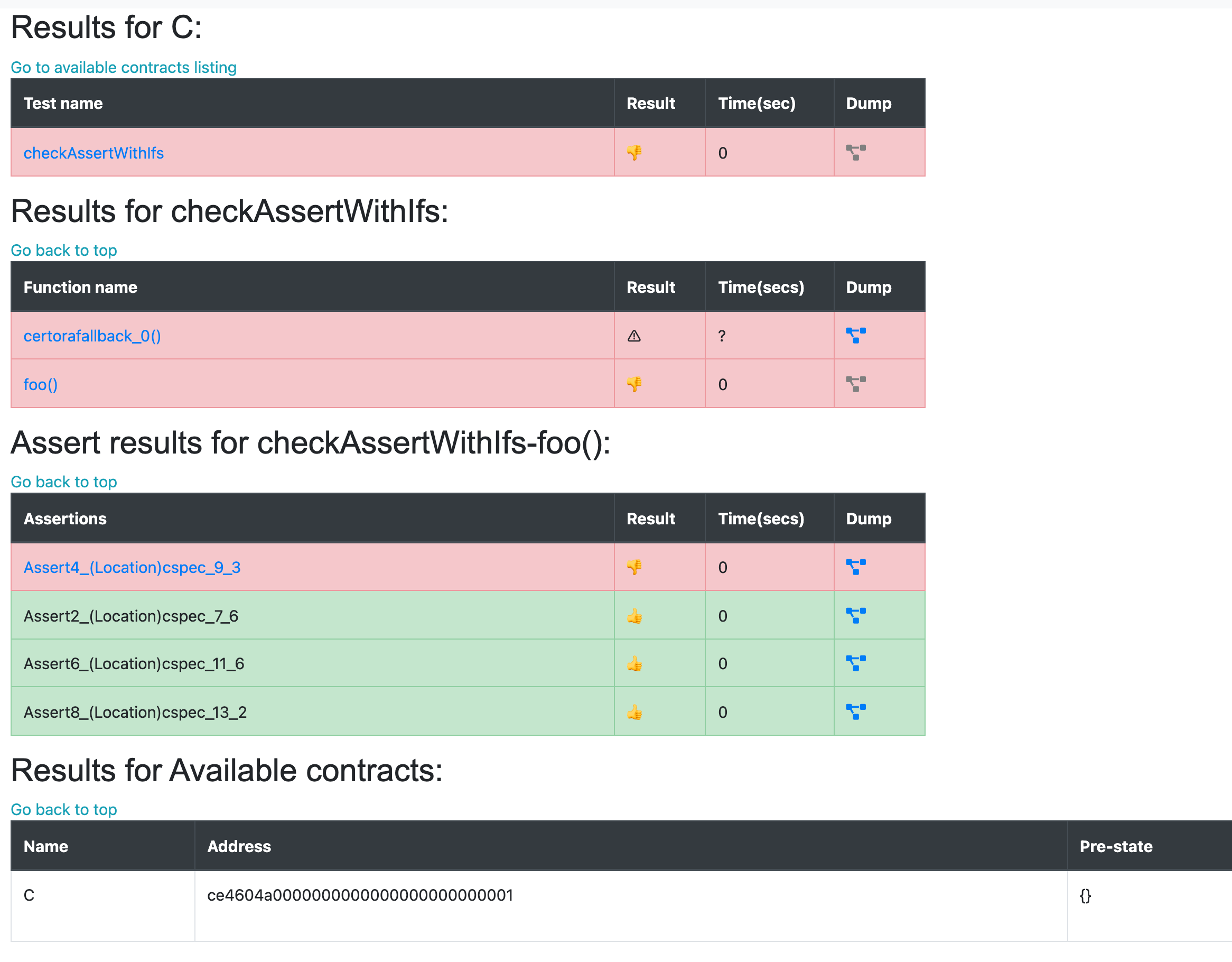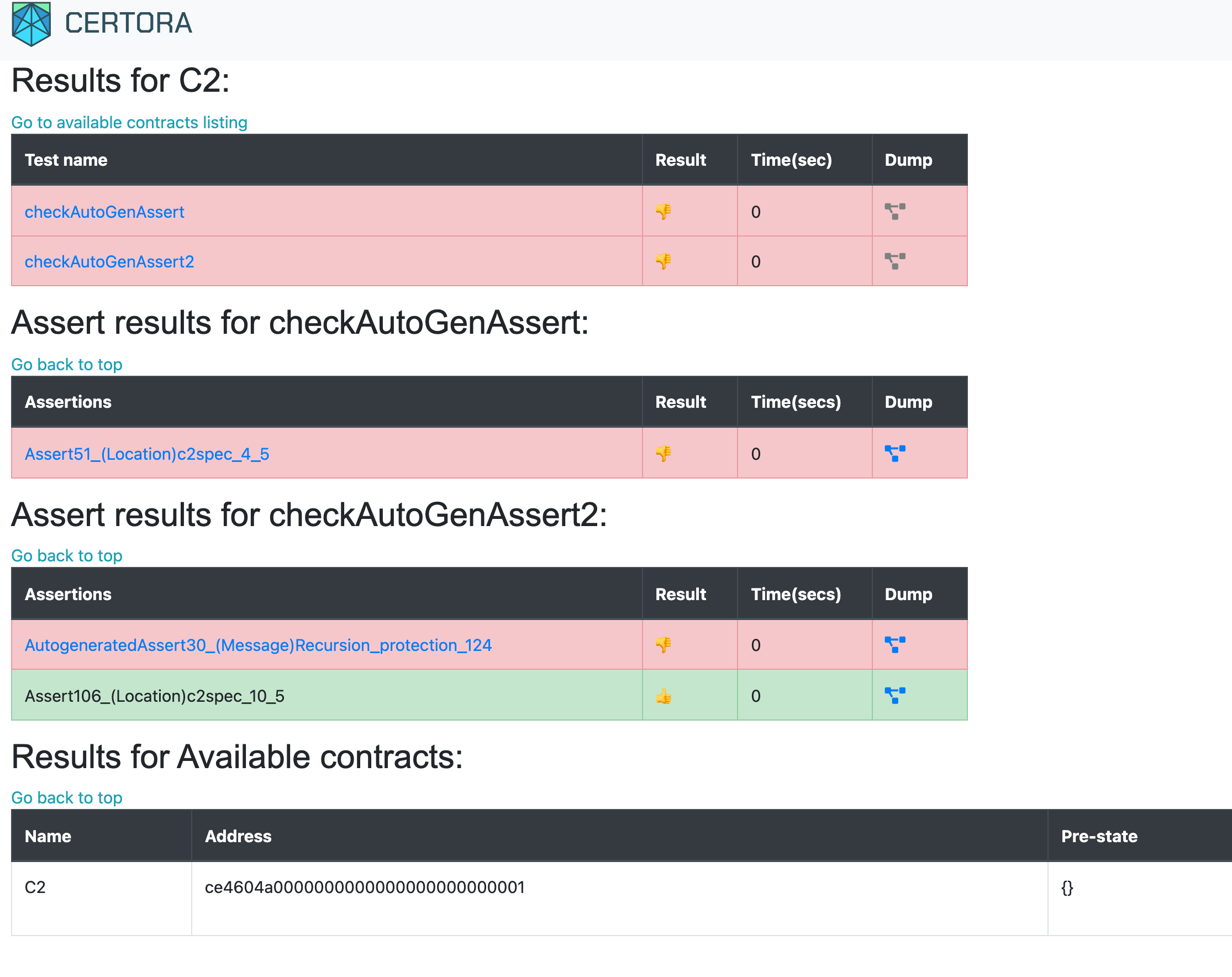Assert splitting
Currently, each rule in the spec file generates a single result, highlighting a conclusion for the entire rule (fail, succeed, timeout, unknown). Even in the case when there are multiple assert statements within a rule, only a single result is generated. However, with the addition of assert each rule is now split into multiple sub rules, one for each of the asserts present in the rule. The rule is split not only on the user specified asserts, but also on the asserts that are automatically generated by the tool itself (the tool generates some assert statements to check against infinite recursion, stack overflows, etc.).
How the sub rules are generated
For each (TAC) assert command, a new sub rule ending at that assert command (target assert) is generated, ignoring the remaining code after the target assert. Moreover, all the asserts that come (topologically) before the target assert command are converted into assume commands in the sub rule. Thus, you can think of a sub rule as checking a single target assert assuming the previous asserts hold. Hence, you can think of assert splitting as follows: the following rule
rule checkElseNotExecuted(mathint r) {
uint256 curr = counter();
env e;
assert counter() == curr;
uint x = true ? 7 : inc(e);
assert counter() == curr, "Value not equal, else branch executed above";
assert x == 7;
uint y = 2 == 3 ? dec(e) : 42;
assert counter() == curr, "Value not equal, then branch executed above";
assert y == 42;
uint z = r > 5 ? inc(e) : dec(e);
assert counter() != curr, "Value equal, both branches executed above";
}
will be split into the following sub rules:
rule <ruleID>1 (mathint r) {
uint256 curr = counter();
env e;
assert counter() == curr;
}
rule <ruleID>2 (mathint r) {
uint256 curr = counter();
env e;
assume counter() == curr;
uint x = true ? 7 : inc(e);
assert counter() == curr, "Value not equal, else branch executed above";
}
rule <ruleID>3 (mathint r) {
uint256 curr = counter();
env e;
assume counter() == curr;
uint x = true ? 7 : inc(e);
assume counter() == curr, "Value not equal, else branch executed above";
assert x == 7;
}
...
rule <ruleID>6 (mathint r) {
uint256 curr = counter();
env e;
assume counter() == curr;
uint x = true ? 7 : inc(e);
assume counter() == curr, "Value not equal, else branch executed above";
assume x == 7;
uint y = 2 == 3 ? dec(e) : 42;
assume counter() == curr, "Value not equal, then branch executed above";
assume y == 42;
uint z = r > 5 ? inc(e) : dec(e);
assert counter() != curr, "Value equal, both branches executed above";
}
The ruleID for each of the sub rules above is formed based on the target assert command.
If it is a user specified assert, the rule name will have the form:
Assert51_(Message)<user specified msg with the assert>if the user has specified an assert message orAssert66_(Location)cspec_46_2if there is no assert message associated with the assert, it displays the location of the target assert: Filec.spec, line46, column2.51and66in the above rule names are assert ids assigned by the tool to the target assert commands. They are mostly there for ensuring uniqueness of different assert commands
For automatically generated asserts, we have
AutogeneratedAssert30_(Message)Recursion_protection_124if there is a message associated with the automatically generated assert orAutogeneratedAssert30_(Symbol)bwhen there is no message. (NOTE: In the future, we plan to incorporate solidity source file information (that produced the automatically generated assert) in the rule name)
Here is another example:
rule checkSoundness {
bool b;
assert !b;
assert !b;
}
The above rule will fail when the model assigns b = true. With assert splitting, it will show two sub rules:
// fails when model assigns b = true
rule 1 {
bool b;
assert !b;
}
// passes
rule 2 {
bool b;
assume !b;
assert !b;
}
As discussed later, the report will show the results for both the asserts and will also summarize the entire rule’s result as a failure (as expected).
What if I have an assert command within an if-else statement
If your code has assert commands within if-else statements,
rule checkAssertWithIfs(method f) {
env e;
calldataarg arg;
f(e, arg);
bool b = false;
if (f.isFallback) {
assert b;
} else if (f.selector == foo().selector) {
assert b;
} else {
assert b;
}
assert false;
}
You can think of assert splitting as generating the following rules:
1st assert (line 7)
rule 1(method f) { env e; calldataarg arg; f(e, arg); bool b = false; if (f.isFallback) { assert b; } else { assert true; } }
2nd assert (line 9)
rule 2(method f) { env e; calldataarg arg; f(e, arg); bool b = false; if (f.selector == foo().selector) { assert b; } else { assert true; } }
3rd assert (line 11)
rule 3(method f) { env e; calldataarg arg; f(e, arg); bool b = false; if (!f.isFallback && !(f.selector == foo().selector)) { assert b; } else { assert true; } }
4th assert (line 13)
rule 4(method f) { env e; calldataarg arg; f(e, arg); bool b = false; if (f.isFallback) { assume b; } else if (f.selector == foo().selector) { assume b; } else { assume b; } assert false; }
Think of the program in terms of a control flow graph. Lets call the block/node which contains the target assert the target block. Now, when we split a rule on the target assert, we only consider the blocks from which the target block is reachable. If a block has two outgoing edges (e.g. if statements) and one edge points to a block B from which the target block cannot be reached, the subgraph beginning at B will be replaced by a dummy block containing a single command assert true. If the program execution reaches this dummy block, we’ll know that the target assert is not violated for that execution. Lastly, after the control flow graph has been modified, all the previous assert commands still remaining in the modified graph are converted into assume commands as before.
Note that rule 4 above will pass vacuously because all program paths to the target assert have assume false before the target assert is reached.
Report
These sub rules are then verified in parallel and the result of the rule is displayed in the report as follows:
When all the sub rules succeed, the report shows only a single SUCCESS result for the entire rule (same as what the report displayed originally)
When any of these sub rules do not succeed (fail, timeout or give an unknown result), the report shows individual results for
a) all the user specified asserts
b) all the automatically generated asserts that did not succeed
Here are some example reports for the rules above:
checkSoundness:

checkAssertWithIfs:

Note that checkAssertWithIfs is a parametric rule. For parametric rules, assert splitting of the rule is performed for each function.
Here is also an example of automatically generated asserts:
// C2.sol
contract C2 {
function foo(uint32 _count) public returns (uint) {
if (_count < 2)
return 1;
else
return foo(_count - 1) + foo(_count - 2);
}
}
// c2.spec
// auto generated asserts not violated
rule checkAutoGenAssert() {
env e;
assert foo(e, 3) == 4; // fails
}
// auto generated assert violated
rule checkAutoGenAssert2() {
env e;
assert foo(e, 5) == 13; // fails when recurionEntryLimit = 4
}
